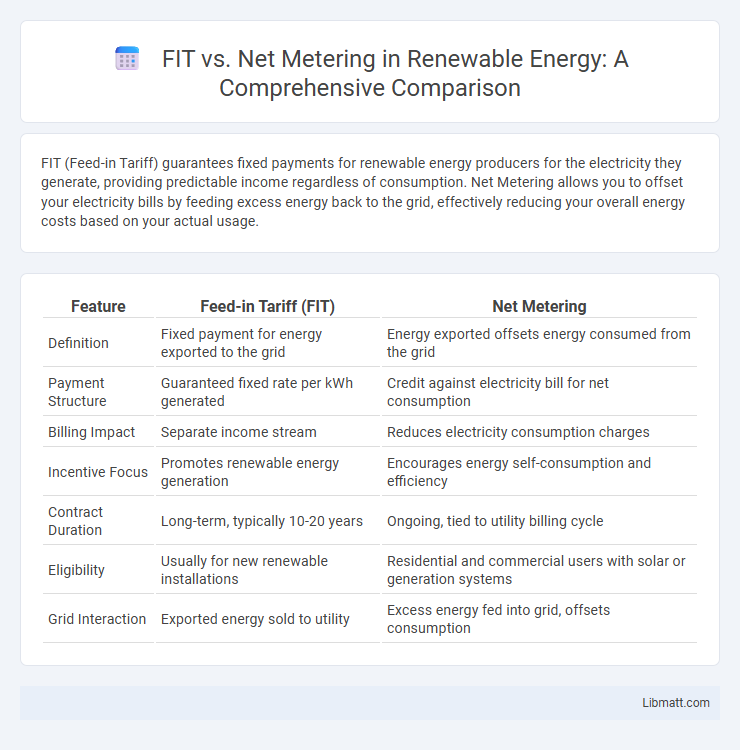FIT (Feed-in Tariff) guarantees fixed payments for renewable energy producers for the electricity they generate, providing predictable income regardless of consumption. Net Metering allows you to offset your electricity bills by feeding excess energy back to the grid, effectively reducing your overall energy costs based on your actual usage.
Table of Comparison
| Feature | Feed-in Tariff (FIT) | Net Metering |
|---|---|---|
| Definition | Fixed payment for energy exported to the grid | Energy exported offsets energy consumed from the grid |
| Payment Structure | Guaranteed fixed rate per kWh generated | Credit against electricity bill for net consumption |
| Billing Impact | Separate income stream | Reduces electricity consumption charges |
| Incentive Focus | Promotes renewable energy generation | Encourages energy self-consumption and efficiency |
| Contract Duration | Long-term, typically 10-20 years | Ongoing, tied to utility billing cycle |
| Eligibility | Usually for new renewable installations | Residential and commercial users with solar or generation systems |
| Grid Interaction | Exported energy sold to utility | Excess energy fed into grid, offsets consumption |
Understanding FIT and Net Metering: Key Concepts
Feed-in Tariffs (FIT) offer fixed payments to renewable energy producers for every kilowatt-hour of electricity generated and fed into the grid, providing predictable income. Net Metering allows you to offset your electricity consumption by feeding excess power back to the grid, effectively spinning your meter backward and reducing your utility bill. Understanding these mechanisms is crucial for optimizing your solar investment and maximizing financial returns.
How FIT Works: Mechanisms and Benefits
Feed-in Tariffs (FIT) guarantee fixed payments for electricity generated from renewable sources, allowing you to sell surplus energy back to the grid at predetermined rates over a long-term contract, ensuring predictable revenue streams. This mechanism incentivizes investment by providing financial stability, often with premium rates above standard retail prices, which accelerates renewable energy adoption and grid integration. FIT benefits include enhanced energy independence, stable income for producers, and promotion of sustainable energy infrastructure development.
Net Metering Explained: Process and Advantages
Net Metering allows you to generate your own electricity through renewable sources like solar panels and send excess power back to the grid, effectively running your meter backward and earning credits. This process helps reduce your electricity bills by offsetting energy consumption during non-generation periods and promotes energy efficiency. The main advantage is the flexibility it provides, enabling you to maximize the value of your renewable energy system without upfront payments for surplus energy.
FIT vs Net Metering: Major Differences
Feed-in Tariff (FIT) guarantees a fixed payment rate for every kilowatt-hour (kWh) of renewable energy generated and fed into the grid, providing predictable revenue for producers. Net Metering allows users to offset their electricity consumption by sending excess power back to the grid, effectively reducing their utility bills based on the retail electricity rate. The major difference lies in FIT offering fixed payments for total energy produced, while Net Metering credits users only for net energy exported, influencing cash flow and investment returns.
Eligibility Criteria: FIT versus Net Metering
Eligibility criteria for Feed-in Tariff (FIT) programs typically require renewable energy systems to meet specific capacity limits and technical standards set by regulatory authorities to qualify for fixed-rate payments. Net Metering eligibility usually involves residential or commercial customers with on-site renewable installations, subject to interconnection requirements and utility approval, enabling them to offset electricity consumption with credits for excess generation. Both schemes often mandate compliance with local grid codes, metering standards, and sometimes prefer renewable technologies like solar PV or wind within designated capacity ranges.
Financial Incentives and Return on Investment
Feed-in Tariffs (FIT) guarantee fixed payments for surplus solar energy at predetermined rates, ensuring predictable financial returns and a faster return on investment. Net Metering credits excess energy at retail rates, which can fluctuate, potentially leading to lower immediate financial incentives but greater long-term savings on electricity bills. Evaluating local policies and energy consumption patterns is critical for maximizing financial benefits and ROI in either system.
Grid Impact: Integration and Stability
Feed-in Tariffs (FIT) ensure predictable energy export to the grid, promoting stable integration by offering fixed rates for renewable energy contributions. Net Metering balances your energy consumption and production in real-time, enhancing grid stability through dynamic energy flow adjustments. Both mechanisms play crucial roles in maintaining grid reliability while supporting renewable energy integration.
Policy Trends: Global Adoption of FIT and Net Metering
Feed-in Tariffs (FIT) and Net Metering policies have seen widespread global adoption as governments strive to accelerate renewable energy deployment. FIT schemes dominate in regions like Europe and Asia, offering fixed payments for renewable energy generation, while Net Metering is prevalent in North America and Oceania, allowing consumers to offset electricity costs by feeding surplus energy back to the grid. Emerging economies increasingly adopt hybrid models, combining elements of both FIT and Net Metering to maximize renewable integration and promote decentralized energy production.
Choosing the Right Model: Factors to Consider
Choosing between Feed-in Tariff (FIT) and Net Metering depends on your energy consumption patterns and financial goals. FIT offers fixed payments for surplus energy fed into the grid, providing predictable income, while Net Metering credits excess generation against your energy use, reducing your utility bill. Evaluate your solar system size, local regulations, and long-term savings potential to determine which model aligns best with your energy strategy.
Future Outlook: Evolving Trends in Renewable Energy Compensation
Future trends in renewable energy compensation indicate a gradual shift from Feed-in Tariffs (FIT) to Net Metering systems due to increasing grid decentralization and prosumer adoption. Net Metering offers dynamic energy crediting aligned with real-time consumption patterns, enhancing economic incentives for residential and commercial solar installations. Regulatory frameworks are evolving to balance grid stability with consumer benefits, promoting smarter energy management and integration of distributed generation.
FIT vs Net Metering Infographic

 libmatt.com
libmatt.com